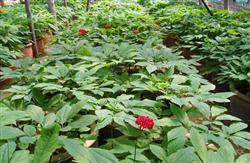How to prevent and cure the bacterial soft rot of ginseng?

How to prevent and cure the bacterial soft rot of ginseng? Please introduce the symptoms of bacterial soft rot of ginseng: mainly harmful to the roots. The disease spot is brown soft rot, the edge is clear, round to irregular shape, different size, constant combination, and finally lead to the whole ginseng root soft rot. Squeeze the disease spot with the hand, there is a white bacterial pus overflow, with a strong irritating smell. When the disease is serious, the whole ginseng root tissue decays and disintegrates. At the initial stage of the aboveground part of the plant, the edge of the leaf turned yellow and curled up slightly, and irregular brown or red spots appeared on the leaf. In severe cases, the whole leaves showed purplish red, and finally the leaves wilted. Wilting developed from recoverability to non-recoverability. The pathogen of ginseng bacterial soft rot is two kinds of bacteria: (1) Pseudomonas caryophyllus Pseudomonas caryophylli Starr et Burkholder, which belongs to Pseudomonas aeruginosa. The cell was rod-shaped, without capsule, polar flagellum and negative for Gram staining. (2) the variety Erwinia carotovoravar of carrot soft rot. Carotovora Bya., belongs to Euclidean bacteria. The mycelium was short rod-shaped, with weekly flagella and negative Gram staining. Incidence regularity of ginseng bacterial soft rot: ginseng soft rot bacteria are abundant in soil, and soil is the overwintering place and primary infection source of soft rot bacteria. Bacteria invade ginseng root mainly through wound. When the ginseng root has strong growth and strong disease resistance, the pathogen is in a latent state. All parts of ginseng root can become the latent place of soft rot bacteria, especially the spore carrying rate is the highest. When the growth of ginseng root is weak, the disease resistance is reduced, or the external temperature and humidity conditions are suitable, the ginseng root appears soft rot symptoms. In the later stage of the disease, it is often co-infected with Fusarium, Rhizoctonia and other fungi, and the mycelium of fungi appear on the outside of the lesion. Prevention and control measures of bacterial soft rot of ginseng: (1) planting ginseng in high and dry land to prevent soil consolidation and stagnant water; do not use seed planting with wound to prevent ginseng root injury when transplanting. (2) strengthen cultivation and management, protect against cold in time in winter, and pay attention to the control of underground pests in order to reduce wounds. (3) soil disinfection: 20% copper acetate wettable powder 50 g / curtain mixed, 80% allicin EC 1000 × 2000 times spray, 50% chlorobromoisocyanuric acid water soluble powder 1000 times, etc. Click to get more ginseng planting technology click to get more medicinal material planting technology
- Prev

How to manage ginseng in autumn, winter and spring?
How to manage ginseng in autumn, winter and spring? Please introduce the method. Autumn, winter and spring are the dormant periods of ginseng overwintering. Field management at this stage is an important production link that can not be ignored. The main task is to prevent cold and preserve soil moisture, the key points of management are: sealing beds in autumn, snow in winter, and digging drainage ditches in spring. Guard against the cold in autumn.
- Next

What kind of medicine can be used to control rice heart borer?
What kind of medicine can be used to control rice heart borer? Please introduce the common name of rice stem borer, Chilo suppressalis and Chilo suppressalis. After these pests are eaten into rice stalks, choose insecticidal mono, diazinon, diazinon, acephate, rice abundant powder, chlorpyrifos, warfarin, avermectin and so on.
Related
- Fuxing push coffee new agricultural production and marketing class: lack of small-scale processing plants
- Jujube rice field leisure farm deep ploughing Yilan for five years to create a space for organic food and play
- Nongyu Farm-A trial of organic papaya for brave women with advanced technology
- Four points for attention in the prevention and control of diseases and insect pests of edible fungi
- How to add nutrient solution to Edible Fungi
- Is there any good way to control edible fungus mites?
- Open Inoculation Technology of Edible Fungi
- Is there any clever way to use fertilizer for edible fungus in winter?
- What agents are used to kill the pathogens of edible fungi in the mushroom shed?
- Rapid drying of Edible Fungi

